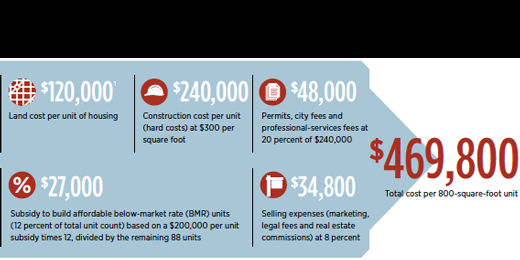Cut Rules in Half and Create 1,960 Affordable Housing Units
I recently posted a comparison of how much housing we’re getting from existing City programs—the Multifamily Tax Exemption (MFTE) and the Levy—and what we’re paying for that housing. I also compared those to Councilmember O’Brien’s questionable tax on new housing. What I found, is that we’re producing a lot of housing every year through these two programs and the cost is low and evenly and fairly spread across all property owners, including wealthy ones. But what if we figured out how to save on permitting and regulatory costs? How many more units could we get if we made permitting easier?
Now, as I pointed out in an article in the Daily Journal of Commerce, with the exception of property tax, almost every cost carried by for profit developers is carried by non-profit developers. These costs include, sales tax, entitlement costs (like design review), land costs, and the increasing costs of labor and materials.
At Forbes, I wrote about a study of California affordable housing that found that costs were substantially increased by public process, including design review. Those costs, combined with parking requirements, added as much as 20 percent to the costs of building subsidized affordable housing. That means tax dollars and credits didn’t create as many units as they could have because of local regulation. This study was conducted and paid for by public agencies.
Finally, San Francisco architect Mark Hogan wrote a great article called The Real Costs of Building Housing, a solid review of why San Francisco is America’s most expensive city. In this article Hogan quantifies the costs of regulation as adding up to about 20 percent, a figure consistent with the study I cited in my Forbes post.
While I wait for more local numbers, I figured I’d put these all together and do the math. How much could we save by paring back regulation on housing? The City says we need 28,000 new affordable units over the next 20 years. Here’s how reducing regulation can create more affordable, subsidized units:
Cost of an affordable housing unit based on industry data: $250,000
Portion of this for construction: 69 percent, $172,500 (from the California study)
Portion of construction that is fees, permitting costs, etc: 20 percent, $34,500 (SPUR Analysis)
Cost of unit if we reduced fees etc. by half: $232,750
Cost of 100 units: $23,275,000
Total savings: $1,725,000
Number of additional units that can be built with savings: 7
Number extra if we built 1400 per year: 98
Over 20 years: 1,960
If we reduced just half of processing permits and other fees paid to the City, we could create 98 more housing units a year (about 1/3 of what the Levy created in 2013) or almost 2,000 over the next 20. There is no question that these numbers are not based on Seattle costs. I’m working on that. But from everything I’ve read and experienced in housing, these numbers are pretty consistent with industry standards. The point? Rather than impose more unfair taxes on new people moving to our city, wouldn’t it be better to take advantage of the tools we have like MFTE and the Levy? Add to that rolling back some regulations and process and we could make a serious dent in the lack of affordable housing supply. Making it easier and less expensive to build translates into more housing which will have a beneficial impact on price.


